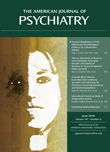Drs. Christian Kieling, Renata Kieling, and Rohde Reply
To the Editor: On the behalf of all authors, we appreciate Dr. Frances' interest in our commentary documenting the rationale for changing the age at onset criterion for ADHD in DSM–5. Since the preparation of DSM–5, the implementation of an evidence-based approach to the development of diagnostic criteria has been an essential step toward strengthening the scientific bases of psychiatric nosology. Any modification in DSM is intended to be a consequence of comprehensive literature reviews, re-analyses of available data sets, and results from field trials (1).
Accordingly, our systematic review of the literature found no evidence for retaining the 7-year-old cutoff as a valid criterion for parsing individuals with and without ADHD. It is important to note that this recommendation derives from 31 studies (including the DSM–IV field trials) assessing a variety of outcomes in multiple settings across different countries (2). Prospective data of an existing data set corroborate these findings, revealing that extending the age at onset criterion to 12 years resulted in a negligible increase of 0.1% in the prevalence of ADHD (3). Results from upcoming field trials should finally assess the suitability and consequences of the proposed modification (4).
The lack of internal and external validity of the 7-year-old cutoff indicates that it impedes the accurate diagnosis of adolescents and adults for whom a comprehensive clinical assessment should identify other more valid criteria in order to reduce false positives (5). Indeed, from a statistical point of view, the inclusion of any additional arbitrary criterion leads to a reduction in the overall prevalence of a disorder. However, as highlighted by Wakefield and Spitzer (6), lower prevalence rates do not necessarily imply more valid diagnostic criteria. The shift from committee-recommended to evidence-based criteria in the development of DSM should be sustained to further increase the clinical validity of the manual.
1 : Toward an empirical classification for the DSM-IV. J Abnorm Psychol 1991; 100:280–288 Crossref, Medline, Google Scholar
2
3 : Implications of extending the ADHD age-of-onset criterion to age 12: results from a prospectively studied birth cohort. J Am Acad Child Adolesc Psychiatry 2010; 49:210–216 Medline, Google Scholar
4 American Psychiatric Association: DSM–5: The Future of Psychiatric Diagnosis. Arlington, Va, American Psychiatric Association, 2010. www.dsm5.org Google Scholar
5 : Against the status quo: revising the diagnostic criteria for ADHD. J Am Acad Child Adolesc Psychiatry 2010; 49:205–207 Medline, Google Scholar
6 : Lowered estimates: But of what? Arch Gen Psychiatry 2002; 59:129–130 Crossref, Medline, Google Scholar



